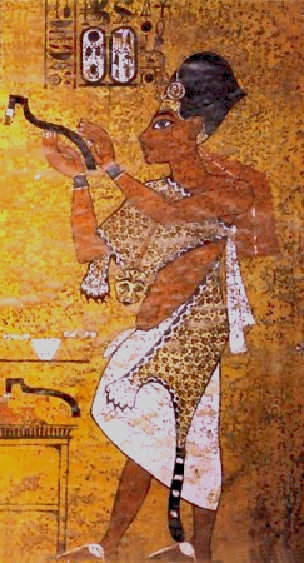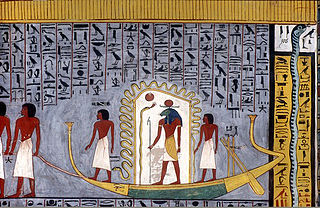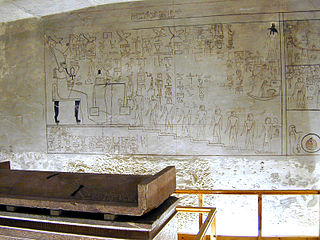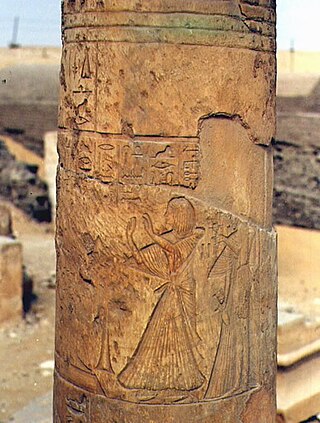Tomb of Horemheb may refer to either of two tombs made for the Eighteenth Dynasty pharaoh Horemheb:
- Tomb of Horemheb in Saqqara, made before Horemheb became pharaoh
- KV57 in the Valley of the Kings, where Horemheb was buried
Tomb of Horemheb may refer to either of two tombs made for the Eighteenth Dynasty pharaoh Horemheb:

Tutankhamun, Tutankhamon or Tutankhamen, also known as Tutankhaten, was the antepenultimate pharaoh of the Eighteenth Dynasty of ancient Egypt. He ascended to the throne around the age of nine and reigned until his death around the age of nineteen. The most significant actions of his reign were reversing the societal changes enacted by his predecessor, Akhenaten, during the Amarna Period: Tutankhamun restored the traditional polytheistic form of ancient Egyptian religion, undoing the religious shift known as Atenism, and moved the royal court away from Akhenaten's capital, Amarna. Tutankhamun was one of few kings worshipped as a deity during his lifetime; this was usually done posthumously for most pharaohs. In popular culture, he is known for his vastly opulent wealth found during the 1922 discovery of his tomb, KV62, the only such tomb to date to have been found in near-intact condition. The discovery of his tomb is widely considered one of the greatest archaeological discoveries of all time.

Neferneferuaten Nefertiti was a queen of the 18th Dynasty of Ancient Egypt, the great royal wife of Pharaoh Akhenaten. Nefertiti and her husband were known for their radical overhaul of state religious policy, in which they promoted the earliest known form of monotheism, Atenism, centered on the sun disc and its direct connection to the royal household. With her husband, she reigned at what was arguably the wealthiest period of ancient Egyptian history. Some scholars believe that Nefertiti ruled briefly as Neferneferuaten after her husband's death and before the ascension of Tutankhamun, although this identification is a matter of ongoing debate. If Nefertiti did rule as Pharaoh, her reign was marked by the fall of Amarna and relocation of the capital back to the traditional city of Thebes.

Horemheb, also spelled Horemhab or Haremhab was the last pharaoh of the 18th Dynasty of Egypt. He ruled for at least 14 years between 1319 BC and 1292 BC. He had no relation to the preceding royal family other than by marriage to Mutnedjmet, who is thought to have been the daughter of his predecessor Ay; he is believed to have been of common birth.

Ay was the penultimate pharaoh of ancient Egypt's 18th Dynasty. He held the throne of Egypt for a brief four-year period in the late 14th century BC. Prior to his rule, he was a close advisor to two, and perhaps three, other pharaohs of the dynasty. It is speculated that he was the power behind the throne during child ruler Tutankhamun's reign. His prenomenKheperkheperure means "Everlasting are the Manifestations of Ra," while his nomenAy it-netjer reads as "Ay, Father of the God." Records and monuments that can be clearly attributed to Ay are rare, both because his reign was short and because his successor, Horemheb, instigated a campaign of damnatio memoriae against him and the other pharaohs associated with the unpopular Amarna Period.

Menpehtyre Ramesses I was the founding pharaoh of ancient Egypt's 19th Dynasty. The dates for his short reign are not completely known but the time-line of late 1292–1290 BC is frequently cited as well as 1295–1294 BC. While Ramesses I was the founder of the 19th Dynasty, his brief reign mainly serves to mark the transition between the reign of Horemheb, who had stabilized Egypt in the late 18th Dynasty, and the rule of the powerful pharaohs of his own dynasty, in particular his son Seti I, and grandson Ramesses II.

The New Kingdom, also referred to as the Egyptian Empire, is the period in ancient Egyptian history between the sixteenth century BC and the eleventh century BC, covering the Eighteenth, Nineteenth, and Twentieth dynasties of Egypt. Radiocarbon dating places the beginning of the New Kingdom between 1570 BC and 1544 BC. The New Kingdom followed the Second Intermediate Period and was succeeded by the Third Intermediate Period. It was Egypt's most prosperous time and marked the peak of its power.

Maya was an important figure during the reign of Pharaohs Tutankhamun, Ay and Horemheb of the Eighteenth Dynasty of Ancient Egypt. Maya's titles include: fan bearer on the King's right hand, overseer of the treasury, chief of the works in the necropolis, and leader of the festival of Amun in Karnak.

Tomb WV23, also known as KV23, is located in the Western Valley of the Kings near modern-day Luxor, and was the final resting place of Pharaoh Ay of the Eighteenth Dynasty. The tomb was discovered by Giovanni Battista Belzoni in the winter of 1816. Its structure is similar to that of the tomb of Akhenaten, with a straight descending corridor, leading to a "well chamber" that has no shaft. This leads to the burial chamber, which now contains the reconstructed sarcophagus, which had been smashed in antiquity. The tomb had also been anciently desecrated, with many instances of Ay's image or name erased from the wall paintings. Its decoration is similar in content and colour to that of Tutankhamun (KV62), with a few differences. On the eastern wall there is a depiction of a fishing and fowling scene, which is not shown elsewhere in other royal tombs, normally appearing in burials of nobility.

Tomb KV43 is the tomb of Pharaoh Thutmose IV in the Valley of the Kings in Luxor, Egypt. It has a dog-leg shape, typical of the layout of early 18th Dynasty tombs. KV43 was rediscovered in 1903 by Howard Carter, excavating on behalf of Theodore M. Davis.

Tomb KV16 is located in the Valley of the Kings in Egypt. It was used for the burial of Pharaoh Ramesses I of the Nineteenth Dynasty. The burial place was discovered by Giovanni Belzoni in October 1817.

Tomb KV57 is the royal tomb of Horemheb, the last pharaoh of the Eighteenth Dynasty and is located in the Valley of the Kings, Egypt.

Tomb KV58, known as the "Chariot Tomb", is located in the Valley of the Kings in Egypt. It was discovered in January 1909 by Harold Jones, excavating on behalf of Theodore M. Davis. The circumstances of the discovery and specifics of the excavation were only given a passing mention in Davis' account, who attributes the discovery to Edward Ayrton in 1907 instead. The tomb consists of a shaft leading to a single chamber and contained only embossed gold foil, furniture knobs, and a single ushabti. The contents likely originated from the Eighteenth Dynasty tomb of Ay in WV23. Davis considered this tomb to be the burial place of the then little-known pharaoh Tutankhamun.

Mutnedjmet, also spelled Mutnedjemet, Mutnodjmet, Mutnodjemet was an ancient Egyptian queen, the Great Royal Wife of Horemheb, the last ruler of the 18th Dynasty. The name, Mutnedjmet, translates as: The sweet Mut.

Amenia was an Egyptian noble lady, the first wife of Horemheb, the last ruler of the Eighteenth Dynasty.

Akhnaton is a play by Agatha Christie. It was written in 1937, around the same time she was writing Death on the Nile. It is set in Ancient Egypt, and followed the exploits of the Egyptian Pharaoh Akhnaton, his wife Nefertiti and his successor Tutankhaton. In writing the play, Christie was assisted by the eminent Egyptologist, Stephen Glanville, who was a friend of both her and her husband, Max Mallowan.

Tia or Tiya was an ancient Egyptian princess during the 19th Dynasty.

The Memphite Tomb of Horemheb is located in the Saqqara necropolis, near Memphis, Egypt. It was constructed before Horemheb ascended to the throne and was never used for his burial, since he later built the Theban tomb KV57 for this purpose. His two wives Mutnedjmet and Amenia were buried within the structure.

Nakhtmin held the position of generalissimo during the reign of pharaoh Tutankhamun of the Eighteenth Dynasty of Ancient Egypt. His titles during the reign of Tutankhamun included "the true servant who is beneficial to his lord, the king's scribe," "the servant beloved of his lord," "the Fan-bearer on the Right Side of the King," and "the servant who causes to live the name of his lord." These titles were found on five ushabtis that Nakhtmin offered as funerary presents for pharaoh Tutankhamun.

The Eighteenth Dynasty of Egypt is classified as the first dynasty of the New Kingdom of Egypt, the era in which ancient Egypt achieved the peak of its power. The Eighteenth Dynasty spanned the period from 1550/1549 to 1292 BC. This dynasty is also known as the Thutmosid Dynasty for the four pharaohs named Thutmose.

Paatenemheb was an ancient Egyptian official who served under pharaohs Amenhotep III and Akhenaten of the 18th Dynasty.